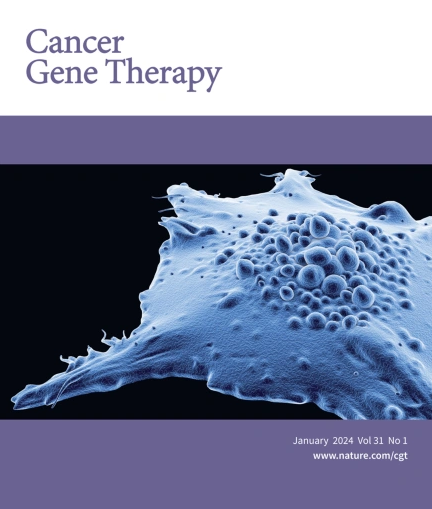由Ewing特异性GGAA启动子驱动的CRISPR/Cas9靶向灭活Ewing肉瘤中的EWSR1:: FLI1基因
IF 5
3区 医学
Q1 BIOTECHNOLOGY & APPLIED MICROBIOLOGY
引用次数: 0
摘要
我们最近通过CRISPR/Cas9证明了基因失活EWSR1:: FLI1,成功地阻断了Ewing肉瘤细胞模型中的细胞增殖。然而,CRISPR/Cas9介导的基因编辑可能会出现脱靶效应,因此,精确调控靶细胞中Cas9的表达对于制定基因编辑策略来灭活Ewing肉瘤细胞中的EWSR1:: FLI1至关重要。在这项研究中,我们证明Cas9可以在Ewing肉瘤细胞中特异性表达,当位于由GGAA重复序列和共识TATA盒(GGAAprom)组成的启动子下游时。在这些条件下,Cas9在表达EWSR1:: FLI1癌蛋白的Ewing肉瘤细胞中选择性表达,而在表达野生型FLI1的细胞中不表达。因此,感染了GGAAprom>Cas9和一种设计用于灭活EWSR1:: FLI1的特异性gRNA的Ewing肉瘤细胞,显示了EWSR1:: FLI1的成功灭活和随后的细胞增殖阻断。值得注意的是,GGAAprom>Cas9在体外和体内都可以通过腺病毒载体有效地递送到Ewing肉瘤细胞中,这突出了该方法治疗Ewing肉瘤的潜力。我们的研究结果表明,在GGAAprom驱动下,CRISPR/Cas9机制对Ewing肉瘤细胞是安全且特异性的,这为基于具有治疗潜力的基因的选择性表达开发癌症基因疗法铺平了道路。本文章由计算机程序翻译,如有差异,请以英文原文为准。

Targeted inactivation of EWSR1 : : FLI1 gene in Ewing sarcoma via CRISPR/Cas9 driven by an Ewing-specific GGAA promoter
We have recently demonstrated that genetic inactivation of EWSR1 : : FLI1 by CRISPR/Cas9, successfully blocks cell proliferation in a cell model of Ewing sarcoma. However, CRISPR/Cas9-mediated gene editing can exhibit off-target effects, and thus, precise regulation of Cas9 expression in target cells is essential to develop gene-editing strategies to inactivate EWSR1 : : FLI1 in Ewing sarcoma cells. In this study, we demonstrate that Cas9 can be specifically expressed in Ewing sarcoma cells when located downstream a promoter consisting of GGAA repeats and a consensus TATA box (GGAAprom). Under these conditions, Cas9 is selectively expressed in Ewing sarcoma cells that express EWSR1 : : FLI1 oncoproteins, but not in cells expressing wild-type FLI1. Consequently, Ewing sarcoma cells infected with GGAAprom>Cas9 and a specific gRNA designed to inactivate EWSR1 : : FLI1, showed successful EWSR1 : : FLI1 inactivation and the subsequent blockade of cell proliferation. Notably, GGAAprom>Cas9 can be efficiently delivered to Ewing sarcoma cells via adenoviral vectors both in vitro and in vivo, highlighting the potential of this approach for Ewing sarcoma treatment. Our results demonstrate that the CRISPR/Cas9 machinery is safe and specific for Ewing sarcoma cells when driven under a GGAAprom, paving the way for the development of cancer gene therapies based on the selective expression of genes with therapeutic potential.
求助全文
通过发布文献求助,成功后即可免费获取论文全文。
去求助
来源期刊

Cancer gene therapy
医学-生物工程与应用微生物
CiteScore
10.20
自引率
0.00%
发文量
150
审稿时长
4-8 weeks
期刊介绍:
Cancer Gene Therapy is the essential gene and cellular therapy resource for cancer researchers and clinicians, keeping readers up to date with the latest developments in gene and cellular therapies for cancer. The journal publishes original laboratory and clinical research papers, case reports and review articles. Publication topics include RNAi approaches, drug resistance, hematopoietic progenitor cell gene transfer, cancer stem cells, cellular therapies, homologous recombination, ribozyme technology, antisense technology, tumor immunotherapy and tumor suppressors, translational research, cancer therapy, gene delivery systems (viral and non-viral), anti-gene therapy (antisense, siRNA & ribozymes), apoptosis; mechanisms and therapies, vaccine development, immunology and immunotherapy, DNA synthesis and repair.
Cancer Gene Therapy publishes the results of laboratory investigations, preclinical studies, and clinical trials in the field of gene transfer/gene therapy and cellular therapies as applied to cancer research. Types of articles published include original research articles; case reports; brief communications; review articles in the main fields of drug resistance/sensitivity, gene therapy, cellular therapy, tumor suppressor and anti-oncogene therapy, cytokine/tumor immunotherapy, etc.; industry perspectives; and letters to the editor.
 求助内容:
求助内容: 应助结果提醒方式:
应助结果提醒方式:


